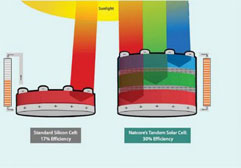Natcore's quantum dots may cause paradigm shift in solar industry
 Natcore Technology (NTCXF.PK) has taken a big scientific step toward eliminating the silicon wafers and all of the cost associated with them in thin-film solar photovoltaics.
Natcore Technology (NTCXF.PK) has taken a big scientific step toward eliminating the silicon wafers and all of the cost associated with them in thin-film solar photovoltaics.
The Rochester, New York-based company has proven the feasibility of all-quantum-dot tandem solar cell technology.
While it may sound positively futuristic, it’s actually right around the corner.
Instead of silicon wafers, the technology creates a silicon film and spreads concentrated “dots” of silicon and germanium on different layers so it can absorb the full spectrum of light, explained Dr. Dennis Flood, Natcore’s CEO.
“Natcore’s LPD technology allows us to make the quantum dots separately, tune their properties to get the range of light absorption we want, and to embed them in sequentially deposited layers of silica,” Flood wrote in an e-mail.
He said lab tests were successful, and the technology allows scientists to fine tune the energy generation by adjusting the diameters of the dots, and the system allows them to incorporate materials other than silicon into the mix, like Germanium, which is more expensive but known for generating power with greater efficiency than silicon.
Flood said that using microscopic dots of the germanium is a more affordable way to incorporate germanium into solar cells.
“Having the ability to make an all-QD tandem solar cell with our LPD technology enables us to put the device on an inexpensive, flexible substrate,” Flood wrote. “And our intent is to make the cells in an unused roll-to-roll film processing plant. Our capital expenditure will be about one-tenth of that required for a conventional thin film solar cell fabrication facility, and we eliminate the use of silicon wafers altogether.”
Flood said he isn’t sure yet how long it will take to translate Natcore’s lab success into a commercially viable product, but he’s confident it will happen.
“We have a lot yet to do in the laboratory to make a fully optimized device,” he said. “Once we do that we have to go through the usual pre-manufacturing steps: lab scale roll-to-roll processing of less than full scale modules, pre-pilot production of limited quantities of modules and finally full scale pilot production. I am not willing to speculate on the time involved at this point.”
But once it happens, the product Natcore plans to introduce to the solar market could change everything. Where thin-film has historically been less efficient than traditional crystalline solar cells, Natcore’s product could be one of the most efficient solar products out there and it could come out at a price point that’s hard to beat.
“Our goal is to reach multi-hundred megawatt per year production rates in a single roll-to-roll line with module efficiencies of 30 percent,” Flood said. “We know we would have a viable product at half that efficiency, but we are working to create a paradigm shift in the industry.”
Image courtesy of Natcore Technology



